 Inverse Trigonometric Function Problems: All Mixed Up
Inverse Trigonometric Function Problems: All Mixed Up
This section gives mixed practice with the three most common inverse trigonometric functions:
All problems should be done without a calculator.
Example 1
Compute: $\,\arcsin(\sin 210^\circ)$
Solution
Caution! Since the sine and arcsine functions are not true inverses, they do not necessarily ‘undo’ each other.
Indeed, $\,\arcsin( \sin 210^\circ)\,$ cannot equal $\,210^\circ\,,$ since the arcsine always returns an angle between $\,-90^\circ\,$ and $\,90^\circ\,.$
Work from the ‘inside’ of the expression to the ‘outside’:
$$\cssId{s14}{ \overset{\text{step 3}} {\overbrace{\arcsin (\ \underset{\text{step 2}} { \underbrace{\sin \overset{\text{step 1}} {\overbrace{210^\circ}} }}\ )}}} $$Step 1
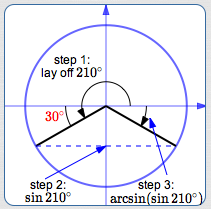
As shown above, lay off a $\,210^\circ\,$ angle ($\,210^\circ = 180^\circ + 30^\circ\,$) in the unit circle. Recall that positive angles are laid off in a counterclockwise direction. Observe that the reference angle for $\,210^\circ\,$ is $\,\color{red}{30^\circ}\,.$
Step 2
By definition of the sine function, $\,\sin 210^\circ\,$ is the $y$-value of the terminal point.
Step 3
Apply the arcsine function: What angle between $\,-90^\circ\,$ and $\,90^\circ\,$ has this $y$-value? Answer: $\,-30^\circ$
Report the Answer
$\arcsin(\sin 210^\circ) = -30^\circ$
Example 2
Find: $\,\tan(\arcsin \frac 45)$
Solution
Step 1
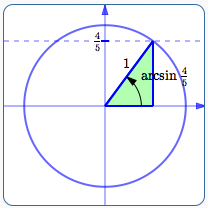
Show the angle $\,\arcsin \frac{4}{5}\,$ on a unit circle. It is the unique angle between $\,-90^\circ\,$ and $\,90^\circ\,$ whose sine value is $\,\frac 45\,$; i.e., the unique angle (in the first quadrant) whose terminal point has $y$-value equal to $\,\frac 45\,.$
Step 2
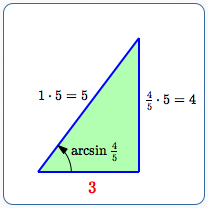
Take the green triangle (which has hypotenuse of length $\,1\,$ and vertical side of length $\,\frac 45\,$) and multiply all the side lengths by $\,5\,.$ This gives a similar triangle with side lengths that are much easier to work with!
Alternative approach for steps 1 and 2:
- Use the right triangle approach only: sine is opposite over hypotenuse
- Draw a right triangle with an acute angle labeled $\,\arcsin \frac 45$
- Mark lengths on the opposite side and hypotenuse, using: $\,\text{sine} = \frac 45 = \frac{\text{OPP}}{\text{HYP}}$
Step 3
Compute the remaining side length in the triangle:
- Immediately recognize the special $\,\color{red}{3}{-}4{-}5\,$ right triangle
- Or, use the Pythagorean theorem: $\,x^2 + 4^2 = 5^2\,,$ so $\,x = \color{red}{3}$
Step 4
Tangent is opposite over adjacent:
$$\cssId{s46}{\tan(\arcsin \frac 45) = \frac{\text{OPP}}{\text{ADJ}} = \frac 43}$$Example 3
Rewrite as an algebraic expression in $\,t\,$: $\,\tan(\arcsin t)$
Solution
This is similar to the prior example, except for the variable $\,t\,$ instead of the constant $\,\frac 45\,.$
For what values of $\,t\,$ is $\,\arcsin t\,$ defined? In other words, what is the domain of the arcsine function?
Answer: $\,t\in[-1,1]$
Initially, we'll suppose that $\,0 \lt t \lt 1\,,$ so you can see the similarity to the prior example. Then, we'll see that the formula obtained also works for $\,t = 0\,$ and $\,-1 \lt t \lt 0\,.$
Since both $\,\tan(\arcsin 1) = \tan(90^\circ)\,$ and $\,\tan(\arcsin(-1)) = \tan(-90^\circ)\,$ do not exist, the expression $\,\tan(\arcsin t)\,$ is not defined at $\,t = \pm 1\,.$
Step 1
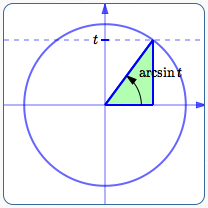
Let $\,0 \lt t \lt 1\,.$ Show the angle $\,\arcsin t\,$ on a unit circle. It is the unique angle between $\,-90^\circ\,$ and $\,90^\circ\,$ whose sine value is $\,t\,$; i.e., the unique angle (in the first quadrant) whose terminal point has $y$-value equal to $\,t\,.$
Step 2
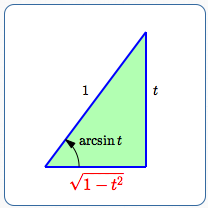
Or, use the right triangle approach: sine is opposite over hypotenuse, so:
$$ \cssId{s66}{\text{sine} = t = \frac {t}{1} = \frac{\text{OPP}}{\text{HYP}}} $$Mark the opposite side as $\,t\,$ and the hypotenuse as $\,1\,.$
Step 3
Compute the remaining side length in the triangle:
$$ \begin{gather} \cssId{s70}{x^2 + t^2 = 1^2}\cr \cssId{s71}{x^2 = 1 - t^2}\cr \cssId{s72}{x = \pm\sqrt{1 - t^2}} \end{gather} $$Since $\,x \gt 0\,$ in this initial discussion, choose the ‘$+$’ sign.
Step 4
Tangent is opposite over adjacent:
$$ \cssId{s76}{\tan(\arcsin t) = \frac{\text{OPP}}{\text{ADJ}} = \frac{t}{\sqrt{1-t^2}}} $$Step 5
Note that the formula also works for $\,t = 0\,,$ as follows:
- $\tan (\arcsin 0) = \tan 0 = 0$
- For $\,t = 0\,$: $\frac{t}{\sqrt{1-t^2}} = \frac{0}{\sqrt{1 - 0^2}} = 0$
Step 6
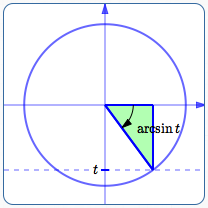
Note that the formula also works for $\,-1 \lt t \lt 0\,,$ as follows:
- In this case, $\,\arcsin t\,$ is in Quadrant IV.
- In Quadrant IV, the tangent is negative.
- The size of $\,\tan (\arcsin t)\,$ is the same as in Quadrant I.
- So, we want a formula that has the same size as $\,\frac{t}{\sqrt{1-t^2}}\,$ and is negative.
- Note that when $\,t\,$ is negative, so is $\,\frac{t}{\sqrt{1 - t^2}}\,$ (since it has a negative numerator and a positive denominator).
Together, $\,\tan (\arcsin t) = \frac{t}{\sqrt{1-t^2}}\,$ for $\,-1 \lt t \lt 0\,.$
Step 7
Combining all the cases:
$$ \cssId{s92}{\tan (\arcsin t) = \frac{t}{\sqrt{1 - t^2}}\ \ \ \text{for}\ \ \ -1 \lt t\lt 1} $$If You Only Need a Reliable Answer ...
Zip up to WolframAlpha and type in:
arcsin ( sin(210 deg) )
tan( arcsin (4/5) )
tan( arcsin t )